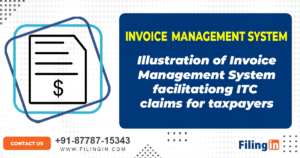GSTN Advisory: IMS Launched for Taxpayers to Streamline ITC Claims
On 14th October 2024, the Goods and Services Tax Network (GSTN) introduced a new system called the Invoice Management System (IMS). This system is designed to help taxpayers accurately claim Input Tax Credit (ITC) by matching their records with the invoices issued by their suppliers. With the launch of this platform, taxpayers now have an efficient way to verify and reconcile their invoices, which is crucial for proper ITC claims.
Let’s dive deeper into what this means for businesses, how the new system works, and what taxpayers need to know about its usage.

What is the Invoice Management System (IMS)?
The Invoice Management System (IMS) is a digital tool that facilitates the reconciliation of invoices between taxpayers and their suppliers. Starting from 14th October 2024, businesses can access this system to ensure that their ITC claims are accurate by comparing their records against the invoices issued by suppliers. This step is crucial in minimizing errors and preventing mismatches that could result in penalties or incorrect tax payments.
Purpose of the IMS
The primary goal of the IMS is to streamline the ITC claim process. Businesses often face challenges in reconciling their invoices, especially when there are discrepancies between their records and the information uploaded by suppliers. IMS eliminates this confusion by offering a single platform where taxpayers can match, verify, and take action on their invoices.
How Does the Invoice Management System Work?
1. Invoice Matching Process
IMS allows taxpayers to compare their purchase invoices with those uploaded by their suppliers. This process ensures that taxpayers can claim ITC only on the invoices that have been correctly reported by suppliers.
2. Action on Invoices
Starting from 14th October 2024, taxpayers can take actions such as accepting or rejecting the invoices reflected in the system. By doing so, they help the system generate accurate reports, ensuring that the data in the GSTR-2B return is correct.
3. GSTR-2B Generation Based on IMS
The first GSTR-2B (a form used to claim ITC) generated through IMS will be available for the October 2024 return period. Taxpayers can access this form on 14th November 2024. It will consider all the actions taken on invoices within the IMS platform. However, it’s important to note that using IMS for action on invoices is not mandatory for GSTR-2B generation, but it’s highly recommended for accuracy.
Benefits of the Invoice Management System
1. Enhanced ITC Accuracy
By using IMS, taxpayers can ensure that their ITC claims are accurate, leading to fewer errors and reduced chances of discrepancies during audits.
2. Simplified Reconciliation Process
One of the most significant challenges businesses face is reconciling invoices with those uploaded by suppliers. IMS simplifies this process, making it easier for taxpayers to identify and correct mismatches.
3. Reduced Risk of Penalties
Inaccurate ITC claims or mismatched invoices can lead to penalties. With IMS, taxpayers can avoid such risks by ensuring that their records are in sync with those of their suppliers.
4. Improved Transparency
The system enhances transparency between taxpayers and suppliers by providing a unified platform where all relevant data is available for cross-checking.
Key Dates for IMS and GSTR-2B
1. IMS Launch Date
The IMS officially launched on 14th October 2024, giving taxpayers the ability to take action on invoices.
2. First GSTR-2B Generation
The first GSTR-2B form will be generated for the October 2024 return period and will be available to taxpayers on 14th November 2024.
3. Action on Invoices
Taxpayers are encouraged to take action on invoices reflected in the IMS platform, although it is not mandatory for the generation of GSTR-2B.
Why Is IMS Important for Businesses?
Businesses that regularly claim ITC need to be extra cautious when it comes to the accuracy of their invoices. Any mismatch between a company’s purchase invoices and its supplier’s uploaded invoices could lead to rejected ITC claims or delays in processing. IMS helps businesses avoid these issues by providing a clear and efficient way to reconcile and validate invoices.
1. ITC Matching Challenges
Previously, businesses had to rely on manual reconciliation or outdated systems to match invoices. This often led to delays and errors, as mismatches were not immediately apparent. IMS now provides a real-time solution to these challenges, ensuring that businesses can act swiftly and correctly.
2. Better Compliance and Record Keeping
Accurate records are crucial for tax compliance. The IMS enables businesses to maintain proper records of their invoices and ensures that they meet the necessary requirements for ITC claims. This reduces the likelihood of tax audits uncovering discrepancies, helping businesses avoid costly penalties.
How to Use the IMS for ITC Claims
Step 1: Access the IMS Platform
Taxpayers can access the IMS through the GST portal starting 14th October 2024. Once logged in, they can view all the invoices that have been uploaded by their suppliers.
Step 2: Match Invoices
Using the system, taxpayers can compare the invoices in their records against those listed by their suppliers. Any discrepancies can be addressed directly within the platform.
Step 3: Take Action on Invoices
Taxpayers have the option to accept or reject invoices based on their records. If an invoice is incorrect, taxpayers can take corrective actions such as rejecting or marking it for future correction by the supplier.
Step 4: Generate GSTR-2B
Based on the actions taken in the IMS, taxpayers will receive their GSTR-2B form for October 2024 on 14th November 2024. This form will reflect the finalized data after reconciliation.
IMS: Not Mandatory, But Essential
While the IMS offers an essential tool for accurate ITC claims, it is important to note that it is not mandatory for GSTR-2B generation. However, using it can significantly improve the accuracy of ITC claims and reduce the risk of errors or mismatches.
Best Practices for Using IMS
To make the most of the IMS, taxpayers should adopt the following best practices:
1. Regularly Check Invoices
Make it a habit to regularly review the invoices uploaded by your suppliers in the IMS system. This will help you catch any discrepancies early and take corrective actions as needed.
2. Communicate with Suppliers
If you notice consistent discrepancies with a particular supplier, open communication is key. Contact them to ensure that their invoice uploading process aligns with your records.
3. Stay Updated on GSTN Announcements
As the GSTN continues to roll out new updates and features for the IMS, staying informed will help you take full advantage of the platform’s capabilities.
4. Use Technology to Simplify the Process
Consider integrating accounting software with the IMS platform for automatic invoice matching. This can save time and reduce the possibility of human errors.
Conclusion
The launch of the Invoice Management System (IMS) by the GSTN marks a significant step in streamlining the process for claiming Input Tax Credit (ITC). By offering a unified platform for matching invoices, taxpayers can now ensure that their claims are accurate, reducing the risk of penalties and improving compliance. Although using IMS is not mandatory, it’s an invaluable tool for businesses aiming to avoid mismatches and improve the overall accuracy of their tax filings.

